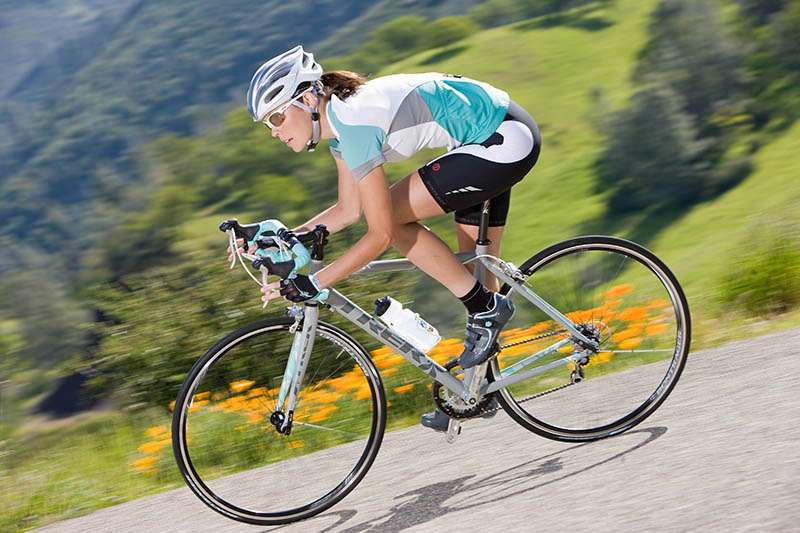A Beginner’s Guide to Road Bikes
You borrowed a friend’s bike for a local group ride and had a great time. Now you’re tempted to buy your own.
Are all road bikes the same?
Or maybe you’re a seasoned mountain biker, but your office pals are roadies and keep inviting you to join them. Every reason is acceptable to get a bicycle, and in this case, a road bike.
You aren’t knowledgeable on the subject, so where do you begin?
You’ve landed in the right place. Here’s what you need to know to find the road bike that’s right for you.
On This Page
Should I Get A Road Bike?
A roadie may not be the best person to ask. To them, the answer is obvious, a resounding, yes! But that’s advice from people who have already gone down the rabbit hole.
Let’s consider some strong reasons why you should get a road bike too.
- Are you an athlete suffering from gym burnout?
- Is the music in your spin class too loud for your tastes?
- The sunshine and fresh air are calling to you, so why are you still riding a stationary bike inside?
You’re the perfect candidate for a road bike. Leave the dreary gym walls and class behind for the great outdoors. You’ll still be working hard, but doing so outside.
Have you put on a few pounds and finally decided to get back into shape?
The gym or a home trainer isn’t for you. You’d prefer to ride in a group to meet new people to help you stay motivated. Road biking is very social, and your local shop or club has a regular group ride. Now all you need is your own road bike to join in the fun.
Road riding is an excellent way to meet your future partner. Although it has improved, there’s still a massive disparity between men and women road riders. Gender aside, road riding is an opportunity to meet like-minded people who share a healthy habit. If you ride together, no one’s at home watching the clock.
Gas prices keep going up, so has your drive time to the office. Today, many businesses offer incentives for employees to ride their bikes to work. You’ll be doing something beneficial for your health, saving some money and reducing stress while having a positive effect on the planet. Get yourself a road bike and you won’t have to say no to that morning donut with your coffee.
Are you a former competitive cyclist?
Or a runner with repeat injuries, so you’re ready to switch to road cycling?
A new road bike will rekindle the love of any former competitor, or relieve injuries caused by weight-bearing sports like running. Bikes have changed over the years, so what’s new in the market?
Read on to find out.
Types of Road Bikes
The term road bike is extensive, and a one-bike-fits-all mentality is a thing of the past. If there’s a special type of terrain you want to ride, there’s a bike for that.
Road bikes abound with niches like all-road, racing, sport riding, touring and commuter, endurance/gran fondo and custom-built.
While all the bikes mentioned are fit for riding on smooth paved surfaces, some of them can also travel off-road, handling hard-pack dirt trails and various levels of rough terrain. Names vary, but if this type of riding piques your interest, look for gravel, adventure, or all-road in the name or description.
The terrain they navigate depends on tire width and clearance, but this isn’t the only factor. Some are made for pure speed for events like the The Dirty Kanza, while others carry lots of gear up steep climbs during multi-day adventures.
Where you want to ride determines the gearing you’ll need. Verify the terrain you seek is accessible to your home and open to the public before starting your search.
Performance Road Bikes
Top-of-the-line road bikes are lightweight with aggressive geometry to make them fast and ultra-responsive. They’re aerodynamic and feather-light for climbing, the kind you see in professional road racing on TV.
Riders are positioned to cut through the air and climb as efficiently as possible. This type of road bike is built for speed and isn’t comfort-focused.
Endurance Road Bikes
If racing isn’t your bag, yet you can be competitive, you may be interested in participating in sportives on an endurance road bike.
Their geometry places the rider in a more comfortable position for long days in the saddle and the bike itself more forgiving on road vibrations. These bikes have more generous fork clearance to accept wider tires, but not as wide as all-road models.
Commuter Road Bikes
Riding to work is a great way to start your day. 700c-wheeled commuter bikes come in all forms, even with flat bars, and are commonly equipped with fenders for foul weather and panniers to carry a change of clothes, computer, toiletries, etc.
If you commute (or plan to) regularly, leave a pair of shoes at the office, it’s one, or two, fewer things to carry.
Custom Bikes
And if you’ve decided to treat yourself to a custom-built bicycle, bravo!
Speak to your builder to find the geometry that lives up to your dreams. The bike will be built just for you, so you can customize every aspect, from the frame material and it’s compliance down to the paint.
You’ll have a beautiful bike for a lifetime, but it won’t come cheap.
Read More : Should You Get A Custom Bike?
Which Frame Material Should I Consider?
Many options exist for your new road bike’s frame material.
Aluminum, carbon, steel, and titanium are the usual suspects, but today you can find frames made of wood, bamboo, and magnesium among other esoteric materials. However, we’ll be sticking with materials available on your local bike shop floor.
Aluminum Frames
Before the carbon invasion, aluminum was the lightest available material. Today, it’s the most commonly used for entry-level bikes because of its durability and cost savings.
It lost some of its shine to carbon because it transmits every road imperfection back to the rider. To combat this, most aluminum bikes come with a carbon fork to make long days in the saddle more tolerable.
Carbon Frames
Carbon is sought after by many roadies for its versatility, rigidity, and lightweight. It also has amazing dampening properties and its form and compliance can be tailored by changing the carbon layup.
Carbon is used for frames, handlebars, seatposts, stems, wheelsets, and even cranks for its performance. Manufacturing prices have come down over the years, but it remains a costly material, one notch below ti.
Titanium Frames
Before carbon hit the scene, titanium was the hottest material on the market.
It’s half the weight of steel and twice as strong. Riders love how it absorbs road imperfections, and it’s less vulnerable to fatigue stresses and crashes than aluminum. The material itself is difficult to extrude into tubes, so it’s an expensive choice with its own cult following.
Read More :
Steel Frames
Steel was the road bike material of choice for ages, but in the drive for lighter bikes, it started being eclipsed by alloy, carbon, and ti.
It’s the heaviest frame material, yet steel-loyal roadies love it for its comfort and lively feel. Like titanium, steel has its own clique of disciples and is often a custom frame builder’s material of choice.
What Size Road Bike Do I Need?
The answer isn’t cut and dried. People, just like road bike frames, come in different shapes and sizes, which complicates pinpointing the one you need.
The industry has no standardized sizing system, so your position and fit on a 54cm (for example) will vary from one brand to another.
Brands publish sizing charts to guide you in your search.
An important fit criteria is standover height. It’s a starting point in finding the size you need. Where you sit on the bike, if you’re too stretched out or cramped, is another major factor.
Head to your local bike shop to see and try some brands for yourself. Shop salespeople can give you a lot of information and set up a test ride for you. Try before you buy whenever possible.
If you’ve owned a road bike before, start with the same size and see how it goes.
Idem if you’ve ridden the bike of a roadie friend who is close to your height. Keep in mind that what’s comfortable for 5 minutes may not be for 3 hours. Check with a sales professional and compare geometries between brands that strike your fancy.
A full-proof option is to have a professional bike fit before you make a purchase. At the end of your appointment, you receive a detailed report identifying your ideal geometry and the size of the components you need (stem length, bar width, etc.).
Read More : 5 Things to Know Before Getting A Bike Fit
What Type of Gearing Do Road Bikes Use?
2x drivetrains are most commonly found on road bikes. What’s a 2x?
It means there are two different-sized chainrings on the crankset. These two chainrings work with the rear cassette to create the bicycle’s gearing. If a bike has an 11-speed rear cassette, 11 x 2 = 22, your bike would have 22 speeds (a few are lost to overlap).
Road bikes used in competition typically come stock with a 52/36t crankset and an 11-28t cassette on the back. This is a big gear ratio, so to get ready to work.
A compact crankset, less aggressive and made for advanced and sport riders, comes with 50/34t or 36t upfront with an 11-28,29,30, or even 32t cassette. This gearing is better for all-around riding and climbing.
Drivetrains are mechanical, so gear changes occur by physically pulling on a cable via the shift lever, or electronic, meaning a battery makes the change for you. For e-shifting systems like Shimano’s Di2 or SRAM e-Tap, only a light touch on a sensor is required to change gears.
Read More : SRAM Etap vs Shimano Di2 – Which is Better?
Shimano and SRAM dominate the market for drivetrains, but Campagnolo, (a.k.a. Campy) has a long history in road biking as well. Let’s look at the different levels, from lowest to highest, finishing with the electronic version.
| Price | Shimano | SRAM | Campagnolo |
|---|---|---|---|
| $ | Tiagra | Apex | Centaur |
| $$ | 105 | Rival | Chorus |
| $$$ | Ultegra | Force | Record |
| $$$$ | Dura Ace | Red | Super Record |
| $$$$$ | Dura Ace Di2 | Red e-Tap AXS | Super Record EPS |
Should I Go Tubeless?
Tubes and skinny tires have worked for decades without a hitch, yet scientific data proves they aren’t faster or the most efficient. The trend is toward wider tubeless rims and tires run at lower pressures.
I’ll save the science behind this for another day, but in a nutshell, wider, tubeless tires deform less as they roll, making them more energy-efficient. You’ll be faster, more comfortable, and have greater control too.
Unless you specifically want tubeless only, many wheelsets sold today come tubeless ready, meaning if you decide to make the leap, you’re set to go.
There’s a learning curve, but once set up, tubeless tires are easy to maintain, and provide better flat protection. Some roadies aren’t quite ready to make the switch. They’ll stick to their tubes and skinny high-pressure tires, but it’s up to you.
Read More :
Are Disc Brakes the New Norm?
As someone who has disc brakes, I happily accept the extra grams of weight for the braking security I feel and get. I live in a hilly area, so they’re even more important to me. My past rim brakes worked well too, but they require more force and an increased braking distance in wet weather. Disc brakes work all the time, regardless of the elements.
Disc brakes work two ways, either mechanically with a cable that runs through the housing to engage the brake pads, or hydraulically, just like a car, with fluid in a closed system. Disc brakes also leave more clearance around the frame and fork so a wider selection of tire sizes and widths can be used.
It’s not necessarily easy to find a new road bike that doesn’t come with disc brakes. The industry is moving in this direction, but is it because of their superior braking power in all conditions, or because it’s in the bike industry’s interest to sell something new?
Hard to say. People buy what the pros ride, so if they aren’t on discs, the public won’t be either.
Read More : A Beginner’s Guide to Road Bike Disc Brakes
How Much Will A Road Bike Cost Me?
How much do you want to spend?
Road bikes are priced from entry-level to premium and beyond. The end price boils down to your choice of frame material, wheelset, and components, like the drivetrain (group), stem, seatpost, and handlebars.
We want the best deal possible, but keep your expectations in line with your budget. Buying a carbon frame with low-end components may not be the bike you expect.
In this case, start with a quality aluminum frame equipped with better components. One cool thing about bikes, there’s always room for an upgrade. As you improve, the bike can too. If your groupset is decent, swap out the frame in the future for another in the material of your choice. It’ll be like having a whole new bike!
If you like road riding but aren’t sure if your interest will last, get yourself a good used bike. There are heaps of excellent used road bikes for sale on road bike community internet sites, or even at your local shop.
A bit of due diligence can get you a high-end road bike with parts of equal caliber for a reasonable price compared to new.
Top-level road bikes like Specialized’s S-Works Tarmac, Cannondale’s Supersix Black Inc, or Trek’s Madone SLR come with the best components like Shimano’s Dura Ace and Ultegra Di2 and SRAM Red and Force e-Tap AXS. As most roadies have their favorite road groups, bike manufacturers can offer both options to their customers.
Let’s look at what you can expect from a new competition-ready road bike at each price level. Internally routed cables are standard.
Entry-Level (Up to $2,000)
Expect an alloy frame with a performance-minded geometry built for multiple rider positions and a carbon fork.
- Rim or hydraulic disc brakes with 10-speed Tiagra, or an 11-speed 105 group with alloy wheels.
- Carbon or aluminum seatpost, stem and handlebars.
- Average weight: 8.3 to 10 kg (18.2 to 22 lbs).
Mid-Level (From $2,000 to $5,000)
The mid-level pricing offers the widest palette of possibilities in alloy and carbon frames with carbon forks. The geometry is more aggressive, made for an experienced rider.
- 2x mechanical 11-speed Shimano 105/Ultegra drivetrains with hydraulic disc brakes and an alloy wheelset.
- Average weight: 7.5 to 9 kg (16.5 to 19.8 lbs)
Top End (From $5,000 onwards)
Carbon frame and fork, a 2x 11 Shimano Dura Ace/Ultegra, or 12-speed SRAM Red/Force eTAP AXS in a mechanical groupset or in electronic shifting, with hydraulic brakes and either an alloy or carbon wheelset, stem, seatpost and handlebars.
You’ll have a pure lightweight performance road bike with a geometry that’s built for speed, agility and climbing.
Average weight between 6.7 to 7.6 kg (14.7 to 16.7 lbs).
Custom-Built Frame (From $ 4,900)
Other than manual labor and expertise, prices for custom build depend on the choice of frame material (typically steel or ti). If ordering a complete bike and not just a frame, the road group, components, and wheelset that accompany your frame determine what you pay.
Bike weights vary by tubes selected and construction method (lugs or not), but fall between 8 to 9 kg (17 to 19 lbs).
Author Recommended Reads



